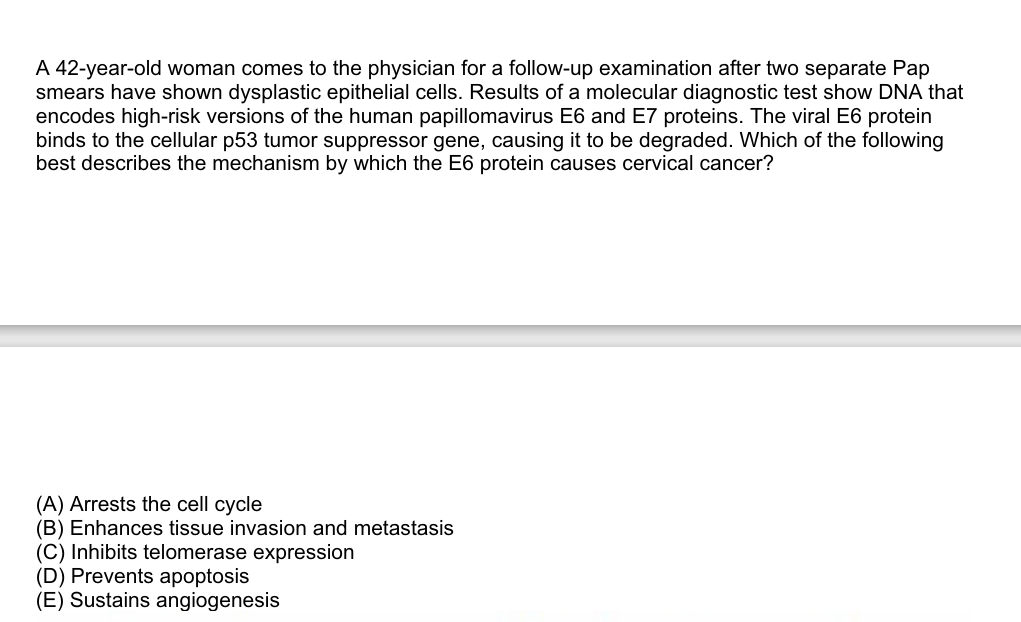A 42-year-old woman comes to the physician for a follow-up examination after two separate Pap smears have shown dysplastic epithelial cells. Results of a molecular diagnostic test show DNA that encodes high-risk versions of the human papillomavirus E6 and E7 proteins. The viral E6 protein binds to the cellular p53 tumor suppressor gene, causing it to be degraded. Which of the following best describes the mechanism by which the E6 protein causes cervical cancer? (A) Arrests the cell cycle (B) Enhances tissue invasion and metastasis (C) Inhibits telomerase expression (D) Prevents apoptosis (E) Sustains angiogenesis
A 42-year-old woman comes to the physician for a follow-up examination after two separate Pap smears have shown dysplastic epithelial cells. Results of a molecular diagnostic test show DNA that encodes high-risk versions of the human papillomavirus E6 and E7 proteins. The viral E6 protein binds to the cellular p53 tumor suppressor gene, causing it to be degraded. Which of the following best describes the mechanism by which the E6 protein causes cervical cancer? (A) Arrests the cell cycle (B) Enhances tissue invasion and metastasis (C) Inhibits telomerase expression (D) Prevents apoptosis (E) Sustains angiogenesis
Human Heredity: Principles and Issues (MindTap Course List)
11th Edition
ISBN:9781305251052
Author:Michael Cummings
Publisher:Michael Cummings
Chapter12: Genes And Cancer
Section: Chapter Questions
Problem 15QP: Which of the following mutations will result in cancer? a. homozygous recessive mutation in a...
Related questions
Question

Transcribed Image Text:A 42-year-old woman comes to the physician for a follow-up examination after two separate Pap
smears have shown dysplastic epithelial cells. Results of a molecular diagnostic test show DNA that
encodes high-risk versions of the human papillomavirus E6 and E7 proteins. The viral E6 protein
binds to the cellular p53 tumor suppressor gene, causing it to be degraded. Which of the following
best describes the mechanism by which the E6 protein causes cervical cancer?
(A) Arrests the cell cycle
(B) Enhances tissue invasion and metastasis
(C) Inhibits telomerase expression
(D) Prevents apoptosis
(E) Sustains angiogenesis
AI-Generated Solution
Unlock instant AI solutions
Tap the button
to generate a solution
Recommended textbooks for you

Human Heredity: Principles and Issues (MindTap Co…
Biology
ISBN:
9781305251052
Author:
Michael Cummings
Publisher:
Cengage Learning

Human Heredity: Principles and Issues (MindTap Co…
Biology
ISBN:
9781305251052
Author:
Michael Cummings
Publisher:
Cengage Learning